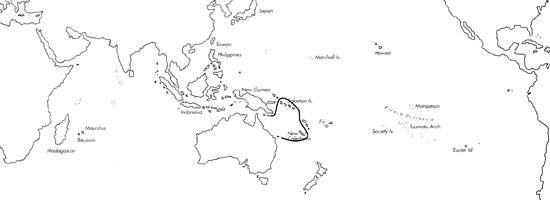
Skip Navigation Links
View access keys for this site.

Range: C. c. coelinae: New Caledonia, Loyalty Is., Queensland; probably also Solomon and Marshall Is. C. c. spiceri: Hawaii.
Description: Moderately large to large, solid to heavy. Last whorl conical; outline straight, except convex below shoulder. Shoulder angulate to sharply angulate. Spire usually low, outline slightly sigmoid. Teleoconch sutural ramps flat to sigmoid, with numerous often faint spiral striae in later whorls. Entire last whorl with rather closely spaced spiral threads, usually more prominent basally.
| Shell Morphometry | ||
|---|---|---|
| L | - mm | |
| RW | - g/mm | |
| RD | - | |
| PMD | - | |
| RSH | - | |
Colour white, variably suffused with yellow. Last whorl ccasionally with a paler spiral band at centre. Base violet or occasionally white in C. c. coelinae (Pl. 31, Figs. 14-16, 20), lemon yellow in C. c. spiceri(Pl. 37, Figs. 17-19). Larval whorls white. Aperture white.
Periostracum yellowish brown to brown, thick, opaque, and almost smooth.
In C. c. spiceri, sole of foot light brown, sides of foot uniform brown, and pedal gland tipped with yellow. Rostrum uniform brown dorsally. Siphon white, grading to grey dorso-laterally on proximal part, with a bright yellow tip followed by 2 blackbands and a pale yellow band between.
Radular teeth with 2 opposed adapical barbs; serration extends about 2/3 the length down the shaft, terminating in a backward-pointing cusp; base with a prominent spur (Kohn, unpubl. observ.).
Habitat and Habits: Intertidal to about 55 m. C. c. coelinae on sand bottoms to about 35 m. C. c. spiceri in 2-55 m, preferring habitats between 12 and 20 m, in coarse sand with coral and coral rubble and beneath dead coral; sometimes encountered in habitats outside the reef. C. c. spiceri feeds on polychaetes (Kohn, 1962; Cross, 1967).
Discussion: C. coelinae is similar to C. virgo, C. berdulinus and C. kintoki. C. virgo can be distinguished by the blue violet basal parts of its shell, purplish larval whorls, and its coarser spiral sculpture on the sutural ramps. C. berdulinus has a less angulate shoulder, smoother last whorl with violet, cream or orange shades, and a thin periostracum. For comparison with C. kintoki, see the DISCUSSION of this species. The two subspecies we characterize are geographiclly widely separated, yet their shells differ only in that C. c. spiceri attains larger maximum size and its base is lemmon yellow, in contrast to the violet base of C. c. coelinae. We do not agree with Delsaerdt's (1989) statement that the holotype of C. coelinae represents a specimen of C. c. spiceri from Hawaii, because its base is white instead of lemon yellow. Specimens of C. c. coelinae with such uncoloured bases are known to occur in New Caledonia (Richard, pers. comm).

C. coelinae range map
This section contains verbatim reproductions of the accounts of 316 species of Conus from the Indo-Pacific region, from Manual of the Living Conidae, by Röckel, Korn and Kohn (1995). They are reproduced with the kind permission of the present publisher, Conchbooks.
All plates and figures referred to in the text are also in Röckel, Korn & Kohn, 1995. Manual of the Living Conidae Vol. 1: Indo-Pacific Region.
The range maps have been modified so that each species account has it own map, rather than one map that showed the ranges of several species in the original work. This was necessary because each species account is on a separate page on the website and not confined to the order of accounts in the book.
Return to framed version (returns to search page)